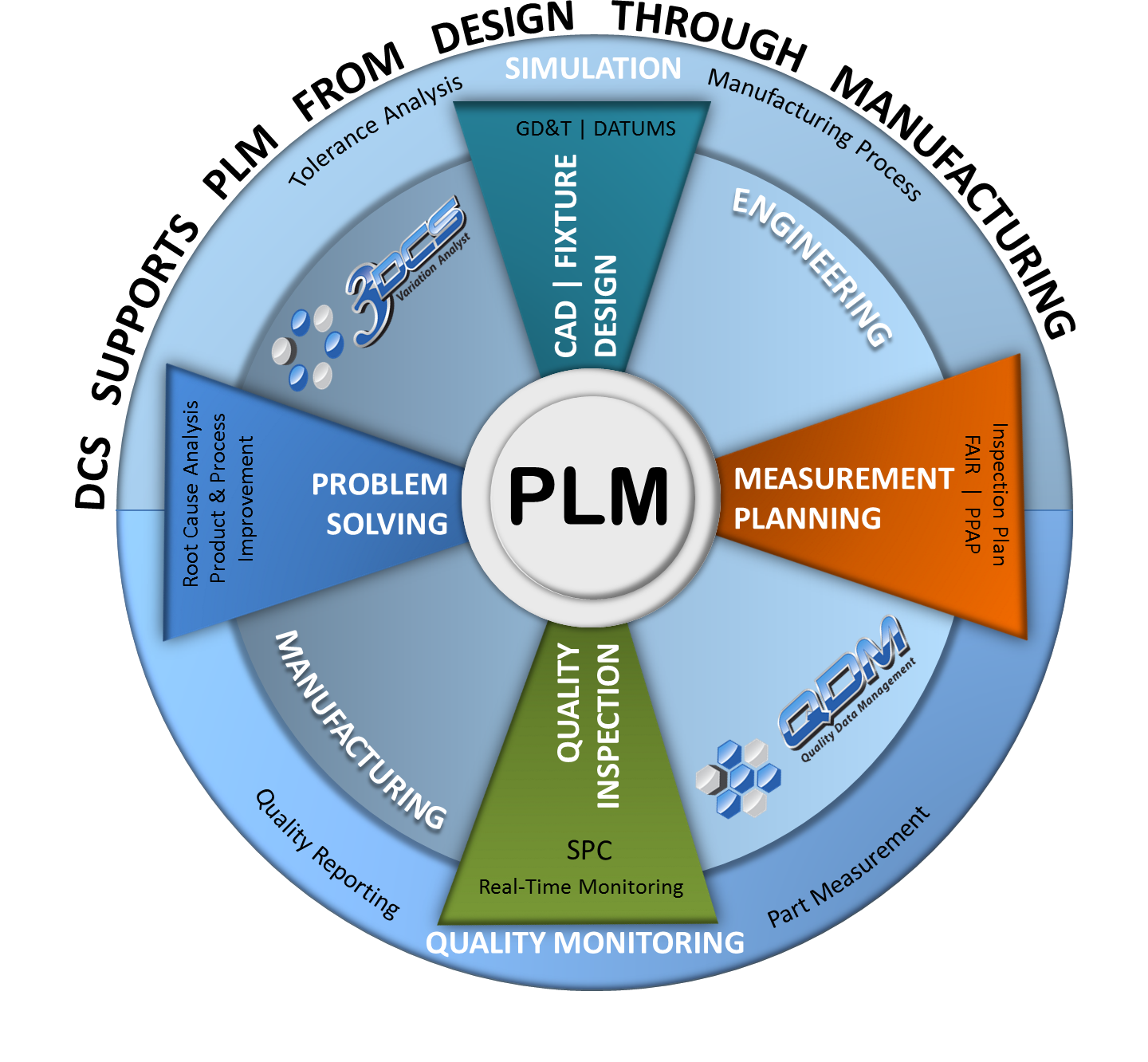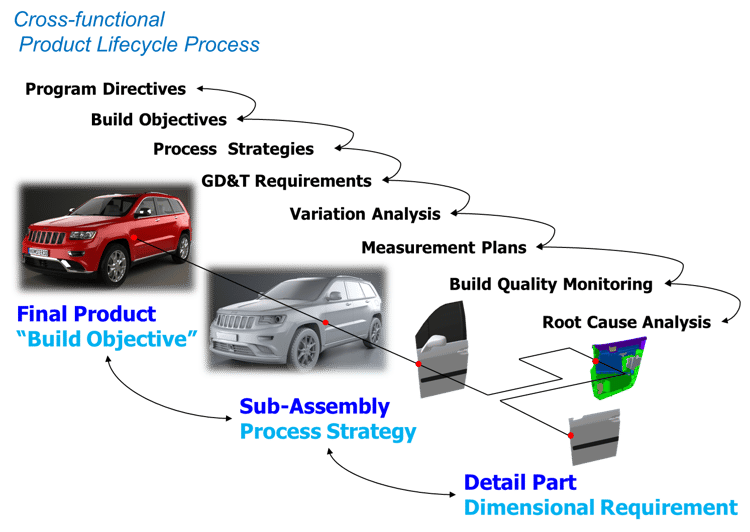
As in many activities such as sports, cooking and especially engineering, a strong foundation is key to success. Whether this is foundational skills like dribbling in Soccer (or Football), chopping and taste testing in cooking, or accounting principles in business, these skills are key to both success and to developing new, advanced skills. In quality and dimensional management, understanding dimensional engineering, tolerance analysis (and oftentimes GD&T), and having clear measurement strategies are important to creating successful projects.
So let's start at the beginning:
Nowadays, each Production Process is an Engineering Management Process (EMP). The EMP is a structured process that focuses on the interactions between People and Machines to make better products in shorter time. Dimensional Management, also called Dimensional Engineering, is a part of the EMP in tape-measurable (dimensional) products, especially in the Automotive, Ship-Building, and Aerospace Industries.
Dimensional Management is the engineering process used to control the overall product quality and cost of production for tape-measurable products.
Dimensional Management is used from the design stage to the manufacturing stage in a product life cycle. Dimensional Control Systems Inc (DCS) specializes in Dimensional Engineering. To facilitate the task of Dimensional Engineering, DCS has developed a suite of software products:
A simple answer is that the tolerances in each part manufacturing process and assembly process are statistical variables.
The statistical simulation tools can provide answers for a question such as what probability does the product have of meeting the requirements, and what percentage of assemblies will meet the requirements? These questions are more critical in the design stage than manufacturing stage for a product.
A good Dimensional Engineering simulation tool, such as 3DCS, should be able to consider designed part tolerances (e.g. the profile tolerance in part manufacturing) AND manufacturing process tolerances (e.g. the tolerance from moving a sub-assembly from one station to another).
In the manufacturing stage, the statistical reporting tools, such as QDM, can be used in controlling manufacturing quality by monitoring the process statistics. By using QDM with the simulation results from 3DCS, an engineer can also statistically compare the manufacturing results with designed results, i.e. simulation results. This method is used in Root-Cause Analysis to find quality-related problems in the manufacturing process.

A well-defined dimensional engineering (DE) process allows for the collection, analysis and application of meaningful variation measurements from design all the way through production. A process solid enough to offer these advantages is not a luxury – today, it’s a requirement for optimal engineering outcomes.
Here are ten reasons why:
A sound dimensional engineering process allows organizations to…
Strong DE identifies the most critical features to a product’s overall quality, which can be used to set build objectives. When a team focuses on what’s critical, a robust design process ensues.
It’s easy to set cost and quality goals that sound good. But it’s a waste of time and energy if they don’t turn out to be feasible. A proper DE process will ensure that isn’t the case.
Automation’s cycle time reductions leave limited windows of time to verify that products meet established tolerances and dimensional specifications. The DE process should allow teams to keep up with increased throughput rates, while maintaining cost and quality goals.
A successful DE process requires successful tolerance analysis. Such analysis predicts each assembly’s dimensional variability and pinpoints sources of variation, which can be used to better a product’s design and assembly processes.
Scrapped parts and reworks often result when specifications are not validated until manufacturing is underway. A strong DE process includes the evaluation of design and assembly concepts in the product development life cycle’s earliest stages.
Sometimes manufacturers are faced with parts that fail inspection, but fit and function properly when assembled. Then, there are the times when parts pass inspection, but do not fit with other parts and assemblies. The DE process can help to deter each of these cases.
Manufacturers and vendors may disagree over whether parts are dimensionally correct. Or, they may have different understandings of design intent. The DE process should supply data that illustrates dimensional accuracy and keeps communications clear.
There are many areas in which the DE process can reduce costs. For example: DCS research shows that nearly 70 percent of a product’s cost commitment occurs in the earliest 5 to 10 percent of the development cycle. Being able to minimize errors in these early stages assures financial benefits.
A closed-loop approach provides feedback from actual product manufacturing to the concept phase to validate and continuously improve design methodologies employed in the organization’s structure. This approach closes the product lifecycle management loop, ensuring product integrity from start to finish. The DE process should allow engineers to quickly pinpoint issues as early as preproduction and then correct them as needed.
As the industry advances, organizations are continuously under pressure to provide products of higher quality at competitive prices. Entrusting a solid DE process to ensure achievement of cost and quality goals takes pressure off of manufacturing teams.

A closed-loop variation analysis process enables engineers to correlate the theoretical tolerance analysis results produced during simulation to the actual as-built results determined at other stages of the quality process. Based on correlations, the as-designed simulation parameters can be validated, or the as-designed simulation parameters can be adjusted to more closely align to production process capabilities.
Additionally, a closed-loop process enables best practices to be validated, captured and reused on future programs, for both engineering simulation and manufacturing. Leading OEMs are beginning to use closed loop systems to improve their program efficiency as they continually face tighter and tighter development cycles and budgets. The intelligence they gather through this system helps them discover ways to reuse existing and proven manufacturing process elements and modularized tooling on new and re-design programs – saving time and cost.
Those OEMs that use a closed-loop variation analysis as a critical part of their quality program are truly able to experience the benefits of an “ounce of prevention.”
Find out more about the DCS Closed Loop Quality
Schedule your free demonstration with a DCS engineer to see for yourself
These Stories on 3DCS
No Comments Yet
Let us know what you think